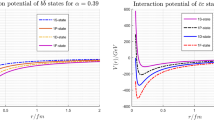Abstract.
In the article under discussion the analysis of the spectra of the unflavored mesons lead us to some intriguing insights into the possible geometry of space-time outside the causal Minkowski light cone and into the nature of strong interactions. In applying the potential theory concept of geometrization of interactions, we showed that the meson masses are best described by a confining potential composed by the centrifugal barrier on the three-dimensional spherical space, \(S^{3}\), and of a charge-dipole potential constructed from the Green function to the \(S^{3}\) Laplacian. The dipole potential emerged in view of the fact that \(S^{3}\) does not support single-charges without violation of the Gauss theorem and the superposition principle, thus providing a natural stage for the description of the general phenomenon of confined charge-neutral systems. However, in the original article we did not relate the charge-dipoles on \(S^{3}\) to the color neutral mesons, and did not express the magnitude of the confining dipole potential in terms of the strong coupling \(\alpha_{S}\) and the number of colors, \(N_{c}\), the subject of the addendum. To the amount \(S^{3}\) can be thought of as the unique closed space-like geodesic of a four-dimensional de Sitter space-time, \(dS_{4}\), we hypothesized the space-like region outside the causal Einsteinian light cone (it describes virtual processes, among them interactions) as the \((1+4)\)-dimensional subspace of the conformal \((2+4)\) space-time, foliated with \(dS_{4}\) hyperboloids, and in this way assumed relevance of \(dS_{4}\) special relativity for strong interaction processes. The potential designed in this way predicted meson spectra of conformal degeneracy patterns, and in accord with the experimental observations. We now extract the \(\alpha_{s}\) values in the infrared from data on meson masses. The results obtained are compatible with the \(\alpha_{s}\) estimates provided by other approaches.
Similar content being viewed by others
References
M. Kirchbach, C.B. Compean, Eur. Phys. J. A 52, 210 (2016)
O.D. Kellogg, Foundations of Potential Theory (Dover, New York, 1953)
L.D. Landau, E.M. Lifschitz, The Classical Theory of Fields, Vol. 2 of A Course of Theoretical Physics, 3rd edition (Pergamon Press, 1971) p. 335
https://en.wikipedia.org/wiki/De_Sitter_invariant_special_relativity
T. Gehrman, M. Jaquier, G. Luisoni, Eur. Phys. J. C 67, 57 (2010)
A.C. Aguilar, D. Binosi, J. Papavassiliou, J. Rodriguez-Quintero, Phys. Rev. D 80, 085018 (2009)
Author information
Authors and Affiliations
Corresponding author
Additional information
Communicated by G. Torrieri
Original Article: Eur. Phys. J. A (2016) 52: 210, DOI: 10.1140/epja/i2016-16210-3
Rights and permissions
About this article
Cite this article
Kirchbach, M., Compean, C.B. Addendum to: Modelling duality between bound and resonant meson spectra by means of free quantum motions on the de Sitter space-time dS4 . Eur. Phys. J. A 53, 65 (2017). https://doi.org/10.1140/epja/i2017-12269-6
Received:
Accepted:
Published:
DOI: https://doi.org/10.1140/epja/i2017-12269-6




